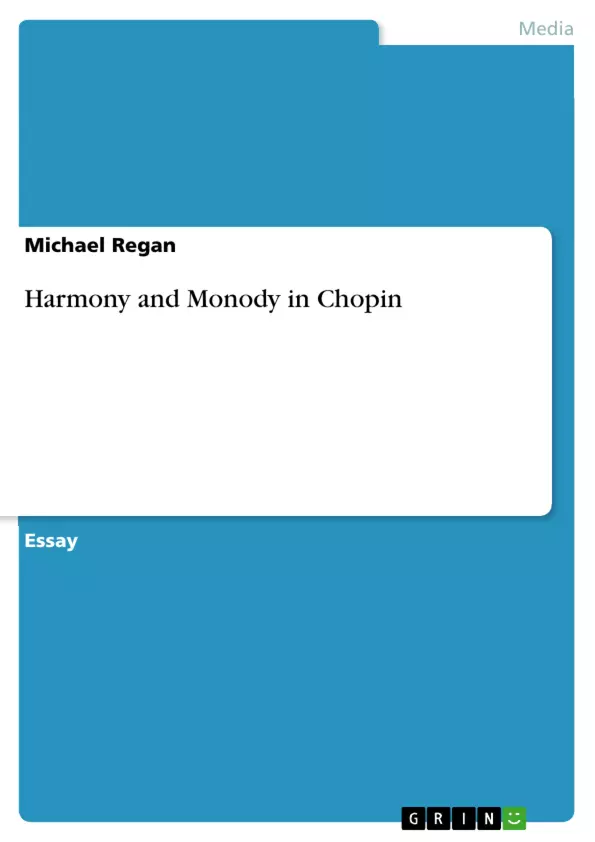Chopin may not have mastered every aspect of the craft of composition. His orchestration is just adequate, for example, and he seldom ventured into longer forms. But he was a master of harmony of the most subtle and original kind, and incidentally (although this is beyond the brief for this essay) of an un-academic counterpoint too, as a glance at some of the late works, such as the Nocturne Op 62 No 1, will demonstrate. His harmonic style is unique to himself and has the distinction of being not only “academically correct” when he employs familiar chord progressions-i.e. leading notes rise and 7ths fall according to the “rules” of traditional harmony, but of going beyond the norms for the early 19th century in the number of unexpected passing modulations, often to remote keys, and often employing enharmonic note-spellings; and in the dissonance level in certain examples which I will come to later.
Inhaltsverzeichnis (Table of Contents)
- Harmony & Monody in Chopin
- Chopin's Dissonances
- Chopin's Modulations
- Chopin's Use of Harmony
- Chopin and Sonata Form
- Chopin's Pre-echoes of Schoenberg
Zielsetzung und Themenschwerpunkte (Objectives and Key Themes)
This essay aims to examine the unique harmonic style of Frédéric Chopin, exploring his mastery of dissonance, modulation, and unconventional use of harmony. It delves into specific examples from his works to illustrate these characteristics and their impact on later composers.
- Chopin's harmonic innovations, including his use of dissonance and modulation
- The influence of Chopin's harmonic style on later composers
- The interplay between harmony and melody in Chopin's music
- Examples of Chopin's unique approach to sonata form
- The presence of pre-echoes of Schoenberg's expressionistic melodies in Chopin's works
Zusammenfassung der Kapitel (Chapter Summaries)
- Harmony & Monody in Chopin: This chapter introduces Chopin's unique harmonic style, highlighting his use of dissonance and unconventional chord progressions. It cites the Scherzo in B minor Op. 20 as a prime example of Chopin's adventurous harmonic approach.
- Chopin's Dissonances: This chapter focuses on Chopin's fondness for dissonant clashes, illustrating this characteristic through examples from various works such as the Prelude in A minor Op. 28 No. 2 and the Nocturne Op 15 No 1.
- Chopin's Modulations: This chapter delves into Chopin's masterful use of modulation, providing examples from the Fantasy in F minor Op. 59 and the 3rd Sonata's slow movement.
- Chopin's Use of Harmony: This chapter examines Chopin's unique approach to harmony, exploring his use of unconventional chord progressions and his ability to evoke a sense of emotional intensity through harmonic choices. It also discusses his occasional complete absence of harmony, as seen in the Finale of the 2nd Sonata Op. 35 and the Prelude in E flat minor Op. 28 No. 14.
- Chopin and Sonata Form: This chapter discusses Chopin's relationship with sonata form, highlighting his preference for using it as a convenient structure rather than exploring its potential for innovation as did Beethoven and Brahms.
- Chopin's Pre-echoes of Schoenberg: This chapter explores potential foreshadowing of Schoenberg's expressionistic melodies in certain works by Chopin, contrasting Chopin's stylistic innovations with those of his contemporaries.
Schlüsselwörter (Keywords)
Key concepts explored in this essay include Chopin's harmonic style, dissonance, modulation, unconventional chord progressions, sonata form, pre-echoes of Schoenberg's expressionistic melodies, and the influence of Chopin's harmonic innovations on later composers.
- Quote paper
- Michael Regan (Author), 2011, Harmony and Monody in Chopin, Munich, GRIN Verlag, https://www.grin.com/document/172054



